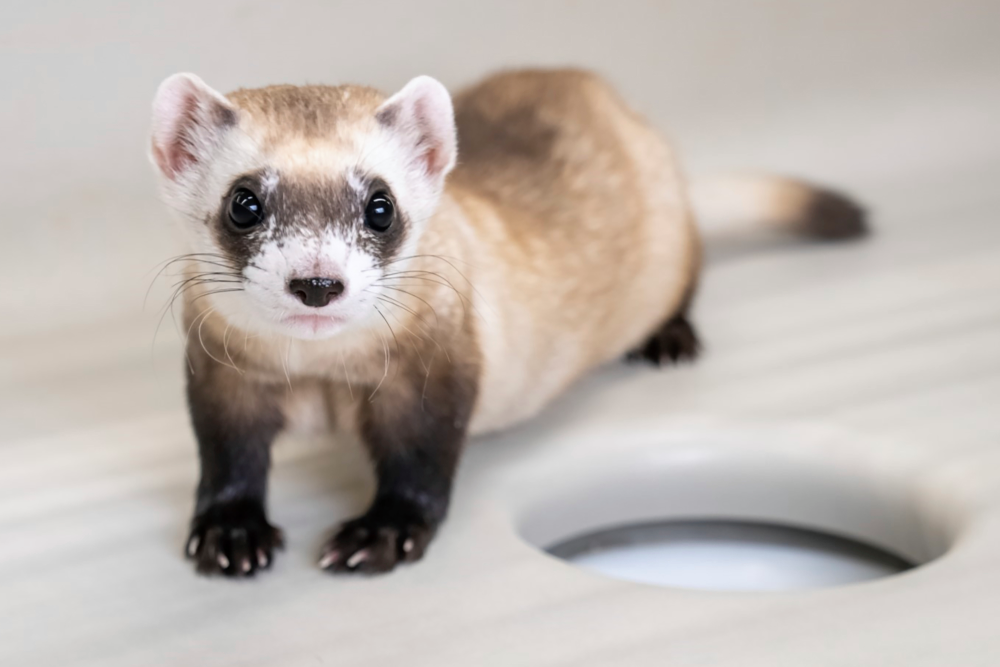 The black-footed ferret (Mustela nigripes) is a captivating yet critically endangered species native to North America. It isph popular for its slender body, masked face, and distinctive black feet. This small carnivore has faced numerous challenges to its survival. These challenges include habitat loss, disease, and the decline of its primary prey species, the prairie dog. Despite being extinct in the wild in the late 20th century, concerted conservation efforts have helped bring this species back from the brink of extinction. Today, the black-footed ferret stands as a testament to the power of collaborative conservation initiatives in preserving our planet’s biodiversity.
The black-footed ferret (Mustela nigripes) is a captivating yet critically endangered species native to North America. It isph popular for its slender body, masked face, and distinctive black feet. This small carnivore has faced numerous challenges to its survival. These challenges include habitat loss, disease, and the decline of its primary prey species, the prairie dog. Despite being extinct in the wild in the late 20th century, concerted conservation efforts have helped bring this species back from the brink of extinction. Today, the black-footed ferret stands as a testament to the power of collaborative conservation initiatives in preserving our planet’s biodiversity.
Physical Characteristics of Black-Footed Ferret
The black-footed ferret is a member of the Mustelidae family, which includes weasels, otters, and minks. It has a long, slender body, short legs, and a bushy tail. The fur on its body ranges from pale yellow to light brown, with a distinctive black mask across its face and black markings on its legs and tail. Adults typically measure about 18 to 24 inches (45 to 61 centimeters) in length, excluding the tail, and weigh between 1.5 to 2.5 pounds (0.7 to 1.1 kilograms).
Habitat and Distribution
Historically, black-footed ferrets inhabited the vast grasslands of North America, from Canada to Mexico. There they relied on prairie dog colonies for food and shelter. However, due to habitat loss and persecution by humans, their range and population declined drastically over the years. By the late 20th century, humans considered the black-footed ferret extinct in the wild, with only a few in captivity.
Life Cycle and Behavior of the Black-Footed Ferret
Black-footed ferrets are solitary and nocturnal animals, spending much of their time underground in prairie dog burrows, which provide protection from predators and harsh weather conditions. They are highly specialized predators, preying almost exclusively on prairie dogs, which make up over 90% of their diet.
Breeding typically occurs in late winter or early spring, with females giving birth to litters of 3 to 5 kits after a gestation period of about 40 days. The kits are born blind and helpless, relying entirely on their mother for care and nourishment. They begin to venture outside the burrow at around 6 weeks old and are weaned at about 8-10 weeks.
Conservation Status and Threats
The black-footed ferret has faced numerous threats to its survival. It includes habitat loss, decline of its primary prey species, disease, and persecution by humans. The widespread extermination of prairie dogs through poisoning, shooting, and habitat conversion has had devastating effects on ferret populations, as prairie dogs are essential to their survival.
By the late 20th century, the black-footed ferret was on the brink of extinction, with only a handful of individuals remaining in captivity. However, intensive conservation efforts, including captive breeding and reintroduction programs, have helped stabilize their population and restore them to parts of their historic range.
Conservation Efforts
Efforts to save the black-footed ferret have involved collaboration between government agencies, non-profit organizations, zoos, and private landowners. Key conservation strategies include:
- Captive Breeding: Establishing captive breeding programs to breed and raise black-footed ferrets for eventual release into the wild. These programs have played a crucial role in increasing the population and genetic diversity of the species.
- Reintroduction: Releasing captive-bred ferrets into suitable habitats within their historic range, with a focus on areas with healthy prairie dog populations. Reintroduction efforts are carefully monitored to assess the success of the releases and address any challenges that arise.
- Habitat Restoration: Protecting and restoring grassland habitats, including prairie dog colonies, to provide suitable habitat for black-footed ferrets and their prey. This involves working with landowners to implement conservation practices that benefit both ferrets and other grassland species.
- Disease Management: Monitoring and managing disease outbreaks, particularly sylvatic plague, which can decimate prairie dog populations and indirectly impact ferrets. Professionals use vaccination programs and habitat management techniques to reduce the spread of disease.
- Public Education: Raising awareness about the plight of the black-footed ferret and the importance of grassland conservation. Educational outreach efforts aim to foster appreciation for these animals and garner support for conservation initiatives.
Successes and Challenges
While significant progress has been made in saving the black-footed ferret from extinction, challenges remain. Habitat loss and fragmentation, disease, and climate change continue to threaten ferret populations, highlighting the ongoing need for conservation efforts.
Despite these challenges, the recovery of the black-footed ferret stands as a remarkable conservation success story. Through collaboration, innovation, and dedication, this species now have a second chance at survival. By continuing to support conservation efforts and protect their grassland habitats, we can ensure that future generations have the opportunity to admire these fascinating creatures in the wild. The black-footed ferret serves as a powerful reminder of the importance of preserving our planet’s rich biodiversity and the irreplaceable value of each species within it.









